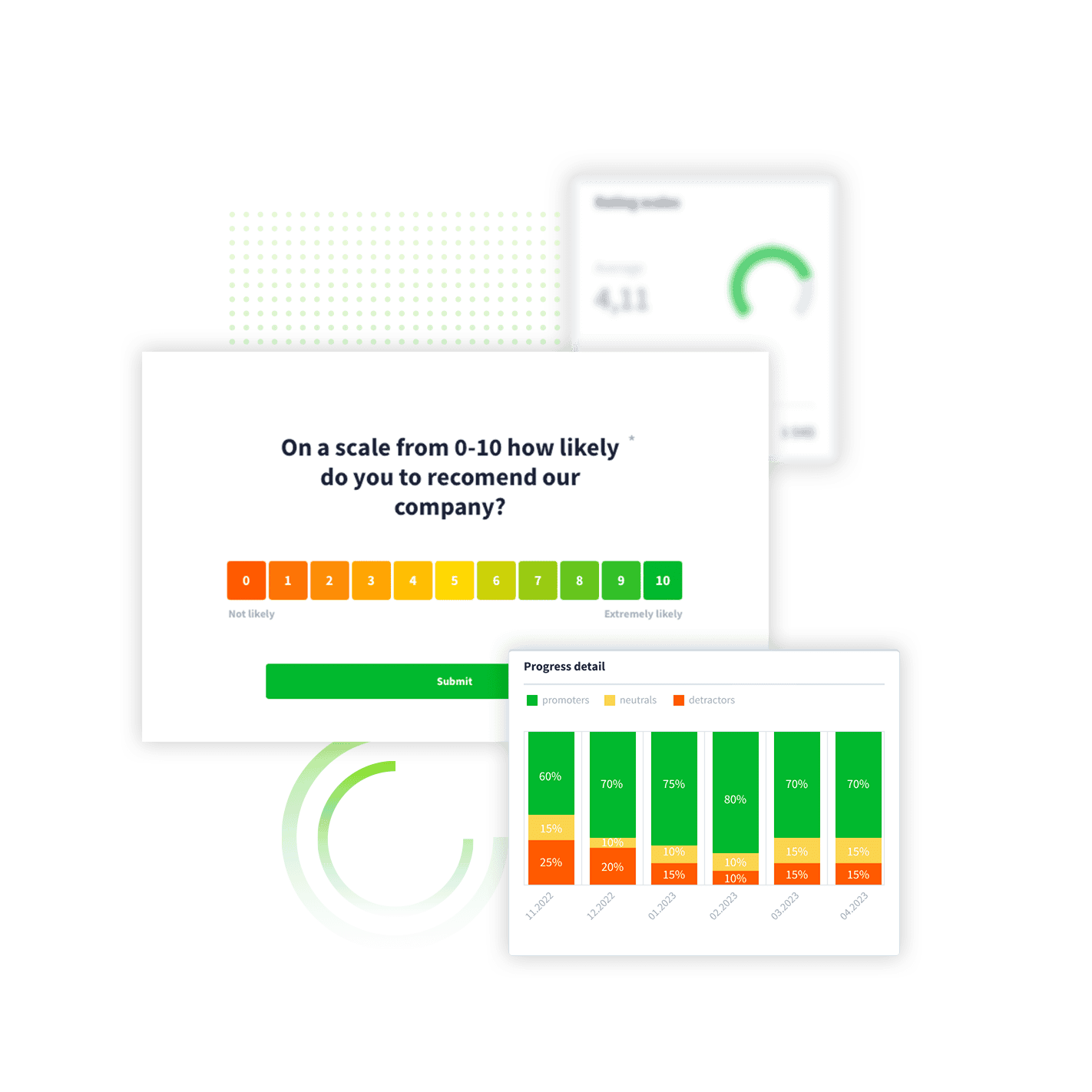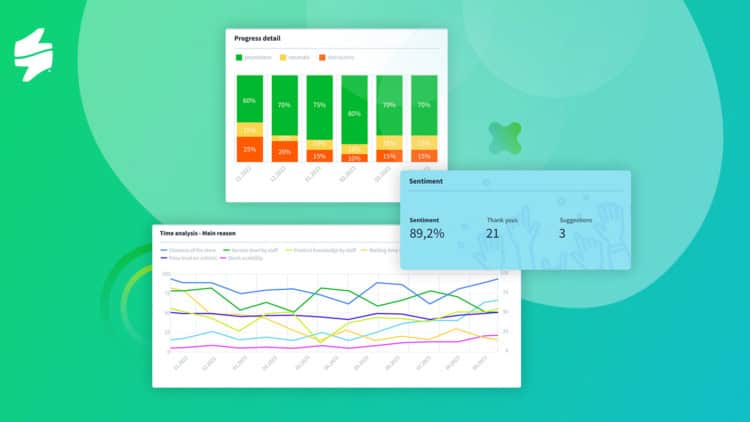Understanding and leveraging the Voice of the Customer (VoC) has become paramount for companies aiming to thrive. VoC refers to the process of capturing customers’ expectations, preferences, and aversions. This comprehensive guide delves into various Voice-of-Customer examples, illustrating how you can implement a robust VoC strategy, utilise the feedback loop, and ultimately reduce customer customer churn.

Voice of Customer (VoC) Definition
At its core, the Voice of Customer encompasses any CX feedback, whether positive or negative, that comes directly from your customers. This feedback can be collected through multiple channels, such as surveys, social media, customer service interactions, and more. A Voice of Customer sample could range from a customer expressing dissatisfaction with a product’s durability to another recommending feature enhancements.

Transform Your Customers' Experiences
Create a bulletproof customer journey with tailored CX products and services that will foster loyalty and reduce churn.
Listening to Voice of Customer Examples
As mentioned above, there are many ways you can listen to the voice of customers, including:
1. Customer surveys and questionnaires
These are among the most direct methods to gather feedback. Customer surveys can be distributed through various channels such as email, websites, or social media platforms, allowing businesses to collect specific insights on customer satisfaction and expectations.

2. Customer interviews
Conducting one-on-one interviews provides deep insights into the customer’s experience and feelings about the product or service. This qualitative method allows for detailed feedback and the exploration of nuances that a customer satisfaction survey might miss.
3. Focus groups
Bringing together a group of customers to discuss their perceptions and experiences can provide a wealth of qualitative data. Focus groups allow for dynamic conversations, where participants can agree, disagree, or build upon each other’s feedback.
4. Social media monitoring
Social platforms are where customers freely express their opinions and experiences. Monitoring these platforms helps companies capture unsolicited feedback, understand customer sentiment, and engage directly with their audience.
5. Online review analysis
Analysing reviews on websites such as Yelp, Google, and Amazon provides businesses with honest customer feedback. These customer feedback methods is invaluable for identifying both strengths and areas for improvement.
6. Customer support interactions
Customer support interactions, whether through calls, emails, or chat, are rich sources of feedback. Analysing these interactions can help identify common issues, gauge the emotional tone of customers, and understand their expectations.
7. Feedback boxes on websites
Implementing a feedback button or box on a website allows customers to easily share their thoughts at the moment. This can be particularly effective for gathering insights on user experience and website functionality.
8. Net Promoter Score (NPS) surveys
NPS surveys ask customers how likely they are to recommend a company’s product or service to others. This simple metric can be a powerful tool for measuring customer loyalty by identifying NPS promoters and improving their satisfaction over time.

9. User Experience (UX) testing
Inviting external customers to test new features or products can provide direct feedback on user experience and usability. This method is especially useful for identifying potential issues before a wide release.
10. Community forums and panels
Creating a space where customers can discuss their experiences, share ideas, and provide feedback fosters a sense of community. It also gives companies a centralised place to gather insights and engage with their most dedicated users.
The Significance of a Voice of Customer Strategy
A well-structured voice of customer strategy is essential for businesses seeking to align their products or services with customer expectations. This strategy involves collecting, analysing, and acting on customer feedback. By doing so, companies can make informed decisions that enhance customer satisfaction and loyalty.
Closed-Loop Feedback: The Heart of VoC Strategy
The concept closed loop feedback is central to the VoC strategy. A feedback loop refers to the process of gathering customer feedback, analysing it, making necessary adjustments, and then communicating those changes back to the customers.

The feedback loop meaning in the context of VoC is about creating a continuous dialogue with customers to refine and improve their experience continuously.
Closing the Loop with Customers
Closing the loop means to follow up with customers who have provided feedback, informing them about the actions taken in response to their input.
This practice, known as closed loop feedback, is crucial for building customer loyalty and trust in your brand. It shows customers that their opinions are valued and have a tangible impact on the business.

Get Actionable Insights with Closed Loop Feedback Management
With Staffino, you'll never leave a customer unhappy again! Streamline the process of collecting and responding to feedback, identify areas of improvement, and make sure that customer issues are addressed quickly and effectively.
Using Voice of Customer to Prevent Churn
Voice of Customer (VoC) is a great tool for identifying potential churners through the collection and analysis of open feedback. Customer churn analysis analysis of customer feedback allows you to identify why customers are leaving and what can be done to retain them. Understanding what is customer churn analysis can help you preemptively address customer issues, reducing the likelihood of customer loss.

By leveraging advanced AI technologies, you can sift through vast amounts of unstructured feedback data – ranging from survey responses and social media comments to customer support interactions. This AI-driven churn analytics then flags expressions of dissatisfaction or intent to leave, which might not be immediately obvious through traditional data analysis methods. Identifying these at-risk customers allows you to proactively reach out and address their concerns to close the loop. This targeted approach not only demonstrates your company’s commitment to its customers but also significantly enhances customer retention management strategies by making them more responsive and personalised.
Example of Voice of Customer Strategies from Renowned Brands
Let’s now look at a concrete example of Voice of Customer strategies from successful brands like Lyreco, Dr.Max, and Orange.
1. Lyreco: Enhancing Customer Centricity through Direct Feedback
Lyreco, a leading distributor of workplace products and services, implemented a VoC strategy focused on capturing direct customer feedback on their delivery drivers to improve their customer-centric approach. The strategy involved:
- Real-time feedback collection: Lyreco leveraged the Staffino CX platform to gather real-time feedback from customers after the delivery of goods. This approach allowed them to understand customer needs and expectations better.

- Employee engagement: Understanding that employees play a crucial role in customer experience, Lyreco used Voice of Customer for employee motivation and engagement. This was achieved by sharing positive customer feedback directly with the employees involved, thereby reinforcing good practices and encouraging a customer-centric culture.
- Actionable insights: The feedback collected was analysed using CX dashboards to derive actionable insights. Lyreco focused on identifying areas of improvement and implementing changes that directly addressed customer concerns, leading to enhanced satisfaction and loyalty.
Check out the full case study here!
2. Dr.Max: Boosting Revenue through a Comprehensive CX Program
Dr.Max, a prominent pharmacy chain, adopted Staffino’s VoC tools to not only improve customer experience but also to increase revenue. Their approach included:
- Customer Satisfaction (CSAT) measurement: By measuring customer satisfaction with their pharmacists, Dr.Max was able to understand customer perceptions and expectations in-depth.

- Employee training: Based on the insights gained from open customer feedback, Dr.Max initiated targeted employee training programs aimed at improving customer service quality.
- Strategic business decisions: The feedback and insights from the VoC program were used to make informed business decisions. This included enhancing in-store experiences, which contributed to increased customer satisfaction and, consequently, revenue growth.
Check out the full case study here!
3. Orange: Improving Customer Retention through Customer Insights
Orange, a major telecommunications operator, implemented a VoC strategy to refine their call centre interactions. Their strategy focused on:
- Comprehensive feedback system: Orange used Staffino customer satisfaction surveys to collect customer feedback on call centre interactions.

- AI feedback analysis: Orange successfully identified at-risk customers through AI-driven semantic analysis of open feedback. Tailored customer retention strategies resulted in savings of €200,000 in a year.
- Customer-centric culture: Beyond service improvement, Orange used the VoC insights to foster a culture of customer centricity within the organisation. By prioritising customer needs and continuously seeking feedback, Orange aimed to build stronger, more positive relationships with their customers.
Check out the full case study here!
Conclusion
In the journey toward unparalleled customer loyalty and reduced churn, embracing the Voice of the Customer is not just a strategy but a necessity. With the right tools and a commitment to listening, you can transform customer feedback into a powerful catalyst for growth and success. We hope the above Voice of Customer samples will inspire you to leverage the insights gained from the VoC to not only meet but exceed customer expectations.

Get a First-Hand Experience Today!
Staffino is the perfect tool for creating engaging surveys, tracking performance, responding to customer feedback, and rewarding top employees. Get started today with our FREE demo!





